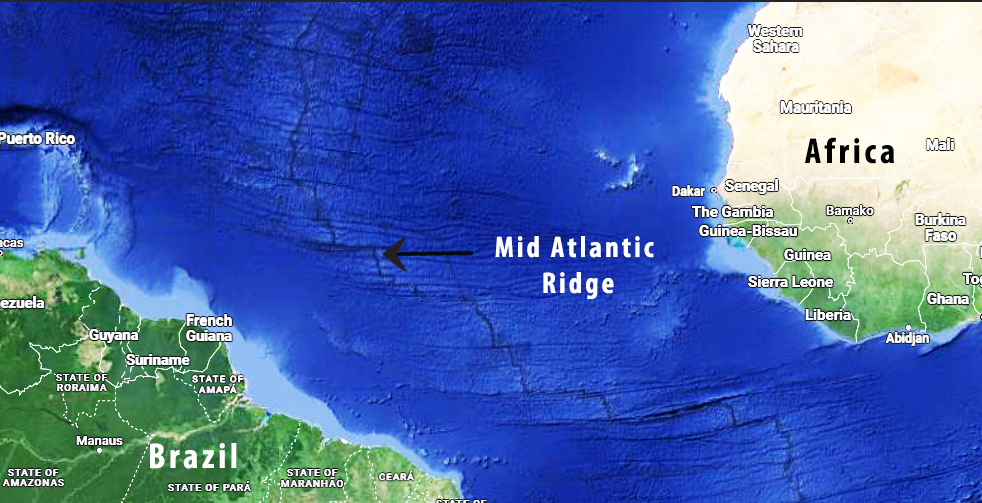Distribution of Oceans and Continents UPSC Notes
Continents cover 29% of the surface of the earth, and the remainder is under oceanic waters. The position of Continents and Oceans bodies has not been constant but has changed in the past. This chapter deals with the various theories related to the movement of the ocean and Continents.
For a long time, many geographers have been amazed by the symmetry of the coastlines on either side of the Atlantic Ocean. As early as in the 16th century, Abraham Ortelius, a Dutch mapmaker, proposed the possibility of the two Americas, Europe and Africa, to be once joined together. Antonio Pellegrini in the 19th century, drew a map showing the three continents together.
However, it was Alfred Wegener who gave the systematic theory of the movement of the continent.
Continental Drift Theory, 1912:
- Continental Drift Theory, 1912:
- Evidence in support of Continental drift:
- Post-Drift Studies:
- Sea Floor Spreading Theory:
- Plate Tectonics:
- Types of Plate Boundaries
- Movement of the Indian Plate
- Role of plate tectonics in the Distribution of Earthquakes and Volcanoes:
- Tectonic activity at Converging plates
- Tectonic activity at Diverging plates
- Relation between Volcanoes and earthquakes
- FAQs related to Distribution of Oceans
It was proposed by Alfred Wegener, a German meteorologist, as a comprehensive argument of Continental drift. It is regarding the distribution of oceans and continents:
- Proposition: A Supercontinent named PANGAEA (meaning all earth) and a mega ocean PANTHALASSA, (meaning all water) existed initially. Pangaea split into two large masses: Laurasia and Gondwanaland forming northern & southern components. These further broke into many pieces.
- Forces responsible for the drift: His explanation was based on the following forces:
- Pole fleeing forces: It is related to the rotation of the earth. It causes outward acceleration experienced by an object moving in a circular path. It leads to the drift of continents towards the equator.
- Tidal forces: Due to gravitational pull from the moon and sun there is the westward movement of the continent. They become effective over thousands of years.
- Current understanding: There is a continental drift but Gravitational forces are very weak and cannot explain it. Thus, the hypothesis was accepted, but not the reasoning behind it.
Evidence in support of Continental drift:
By the mid-20th century, a variety of new evidence was gathered in support of continental drift, as mentioned below:
- Matching the continent (Jig-Saw-Fit): There is a remarkable match in the shorelines of Africa and South America. A map produced using a computer programme to find the best-fit Atlantic margin was presented by Bullard in 1964. The match was tried at a 1000-fathom (6 feet depth of water) line instead of the present shoreline.
- Rocks of the Same Age across the Ocean: Radiometric dating methods have helped in correlating rock formation across different continents. For example, the Belt of ancient rocks of 2000 million years ago from Brazil’s coast matches with those in West Africa.
- Tillite: It is the Sedimentary rock formed out of deposits of glaciers. The Gondwana system of sediments from India is known to have its counterparts in six different landmasses in the Southern Hemisphere: Africa, Falkland Island, Madagascar, Antarctica and Australia. At the base, the system has thick tillite indicating extensive and prolonged glaciation.
- Placer Deposits: The presence of Gold placer deposits on Ghana’s coast and the absolute absence of source rock help in deducing that the gold deposits of Ghana are derived from the Brazil plateau.
- Distribution of Fossils: Identical species of plants and animals adapted to living on land and freshwater are found on either side of marine barriers.
Post-Drift Studies:
Continental drift theory was unable to counter the criticism of the forces responsible for the movement of the continent. Several discoveries during the post–World War II period added new information to geological literature.
- Conventional Current Theory: It was given by Arthur Holmes in 1930. It discussed the possibility of a system of convectional currents operating in the Mantle portion. It is generated due to radioactive elements causing thermal differences. However, it was not fully accepted.
- Mapping of the Ocean Floor: The Ocean floor is not just vast and plain but full of relief. Expeditions provided a detailed picture of the ocean relief and indicated the existence of submerged mountain ranges as well as deep trenches. Thus, it has various reliefs similar to continents.
- Mid-oceanic ridges were found to be most active in terms of volcanic eruptions.
- Dating of rocks from oceanic crust revealed much younger than continental areas.
- Rock equidistance from the ridge on either side has remarkable similarities in terms of age and constituents.
- Distribution of Earthquake & Volcanoes: along belts:
- Atlantic Ocean: symmetrically from along the coast – along mid-ocean ridges. These areas feature shallow earthquake zones hinting towards a thinner crust in these areas.
- Deep earthquake zones: Alpine and Himalayan system, rim of Pacific Ocean. The Rim of the Pacific is called the ‘Rim of Fire‘ due to active volcanoes in the sea.
| Ocean Floor Configuration: |
|
There are four main features of the ocean floor which include (1) continental shelf, (2) continental slope, (3) continental rise, and (4) abyssal plains.
|
Sea Floor Spreading Theory:
Over the years, the Mapping of Ocean floor and Palaeomagnetic studies of rocks from oceanic regions revealed:
- Volcanic eruptions all along mid-oceanic ridges are common and they bring huge amounts of lava to the surface.
- Rocks equidistance from ridges show remarkable similarities in terms of formation period, chemical composition Magnetic Properties. The rocks nearest are the youngest and have normal polarity.
- Ocean crust rocks are much younger than continental as the age of the oceanic rocks is nowhere more than 200 million years. Whereas, the age of Continental rocks sometimes dates back to 3200 million years.
- Sediments on the ocean floor are unexpectedly thin thus it is not as old as continents.
- Deep trenches have deep-seated earthquake occurrences. Mid-oceanic ridges have Earthquake foci at shallow depths, again hinting that the oceanic crust is much thinner.
Hess’s Hypothesis (1961):
The above factors led Hess to believe that the “sea floor is spreading”.
- Hess argued that constant eruptions at the crest of oceanic ridges cause the rupture of the oceanic crust and the new lava wedges into it, pushing the oceanic crust.
- He further maintained that the ocean floor that gets pushed due to volcanic eruptions at the crest, sinks down at the oceanic trenches and gets consumed, as shown in the figure on the next page.
It is therefore clear that there are large segments of the earth’s crust that move continuously in an everchanging process of formation and destruction. This finally led to the popularity of the tectonic Plate theory, which is the best description of the crust that we have today.
Plate Tectonics:
It is a geologic process in which tectonic plates large slabs of Earth’s lithosphere split apart from each other. In 1967, McKenzie and Parker, and also Morgan independently collected available ideas and came out with other concepts termed Plate Tectonics.
It is an improvement over the Continental drift theory (CDT) as it has combined CDT with seafloor spreading theory with the convectional current theory.
- Tectonic Plate: It is a lithospheric plate, a massive irregularly shaped slab of solid rock composed of continental and oceanic lithosphere.
- Plates move horizontally over the asthenosphere as rigid units (Crust +Top Mantle) with thicknesses between 5-100 km in oceanic parts and about 200km in continental areas.
- The plate may be Continental or Oceanic depending on which of the two occupies a larger portion. For Example; the Pacific plate is Oceanic and the Eurasian plate is Continental.
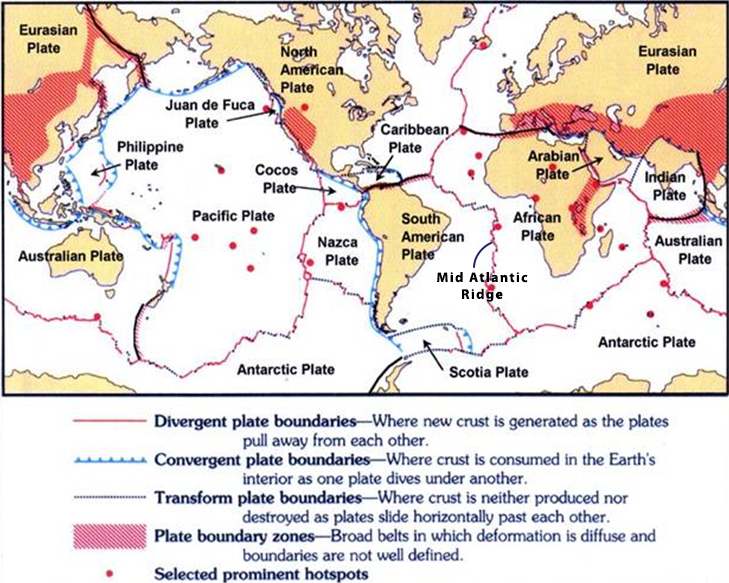
Types of Plate Boundaries
The tectonic plates continuously move to induce earthquakes and volcanoes. All the major earthquakes and volcano zones lie on these boundaries. Following are the three types of plate boundaries based on the interaction of different plates:
-
- Divergent Boundaries: Where new crust is generated as plates pull away from each other. Sites at boundaries are called spreading sites. For example, the Mid-Atlantic Ridge, as shown in the diagram above.
- Convergent Boundary: Where the sinking of a plate occurs it is called a Subduction zone. There are 3 ways of convergence as follows:
- Between oceanic and continental plates. Ex: South American and Nazca plate.
- Between two oceanic plates. Ex: Philippines and Pacific.
-
- Between two continental plates. Ex: India and Eurasian.
-
- Transformation boundaries: Crust is neither produced nor destroyed as plates slide horizontally past each other.
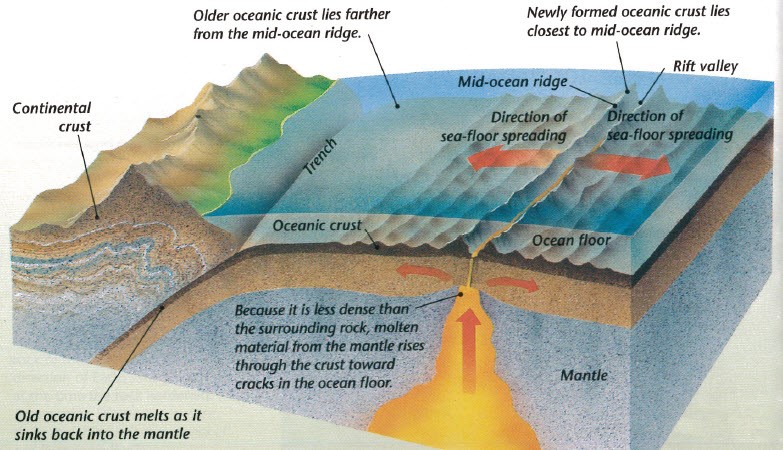
Through Palaeomagnetic data, positions held by each of the present continental landmasses in different geological periods have been determined. We now know that Pangaea was a result of the converging of different continental masses that were part of one or the other plates. The rotation of the earth also has its effect on separated blocks of the plate portions
-
- Rate of plate movement: Strips of reverse and normal magnetic fields that parallel the mid-oceanic ridges help scientists determine the rates of plate movement.
- Arctic Ridge has the slowest rate at 2.5cm/year,
- The East Pacific Rise near Easter Island (South Pacific- 3400km West of Chile) has the fastest rate of movement at 15cm/year.
- Force for plate Movement:
- The mobile rock beneath the rigid plates is believed to be moving in a circular manner. The heated material rises to the surface, spreads begins to cool, and then sinks back into deeper depths. This cycle is repeated over and over to generate what scientists call a convection cell or convective flow. The slow movement of Hot, the softened mantle is the driving force behind the movement.
- Heat within the earth comes from two main sources:
- Radioactive decay and Residual heat.
Movement of the Indian Plate
-
- Indian plate includes Peninsular India and Australian continental portions.
- Northern plate boundary – continent convergence.
- Eastern plate boundary – Rakhine Yoma Mountains of Myanmar towards the island arc along Java Trench. The eastern margin is a spreading site lying in the east of Australia in the form of an Oceanic ridge in South West Pacific Ocean.
- Western plate boundary – It follows the Kirthar Mountains of Pakistan. Further extends along the Makarana coast and joins the spreading site from the Red Sea Rift Southeast along the Chagos Archipelago.
- Southern plate boundary – Situated between Indian and Antarctic plates, which are divergent.
- Indian plate includes Peninsular India and Australian continental portions.
Movement:
-
- India was a large Island situated off the Australian coast in a vast ocean called the Tethys Sea, separated from the Asian continent until 225 million years at the time Pangaea broke.
- It collided with Asia about 40-50 Million years ago causing rapid uplift of the Himalayas.
- 140 million years ago India was 50o Two major plates were separated by the Tethys Sea and the Tibetan Block (Closer to the Asiatic mass).
- A major event occurred that was outpouring lava formation of Deccan Traps started somewhere around 60 million years ago & continued for a long period.
Role of plate tectonics in the Distribution of Earthquakes and Volcanoes:
Plates are thought to float on the molten mantle continuously converging diverging or rubbing against each other.
moving away from oceanic ridges where new plate material is produced and moving past each other or colliding along plate boundaries. Earthquakes and volcanoes are related to this movement.
Volcanoes, however, only occur at constructive and destructive plate margins. A lot of volcanic activity occurs in the ‘ring of fire’. The ‘Ring of Fire’ is a group of volcanoes that are located along the plate margin of the Pacific plate.
Tectonic activity at Converging plates
At a convergent junction, movement is not continuous but intermittent. The colliding plates continuously get pressed against each other and energy keeps building up. Once enough energy is built up to overcome the frictional forces between the plates, the plates move. Generally, one plate subducts under the other. The subducting plates melt into the mantle,
The region of Subduction is associated with volcanoes and earthquakes.
-
- At continent and continent convergence zones, only earthquakes occur. For example: Alpine and Himalayan systems.
- At places where at least one oceanic plate is involved in the subduction, volcanic activities are common along with earthquakes. Here, we must remember that the oceanic plate is heavier and therefore easily subducts below the continental place.
- Reason for the Earthquake in such zones: When the moisture-laden crustal plate comes in contact with the Mantle, the moisture expands due to high temperature and leads to explosive rupture on the plate boundaries. This causes volcanos and is associated with Deep earthquake zones.
- Examples: Krakatoa volcano in Indonesia.
-
- The Pacific Ring of Fire – a chain of earthquake and volcanic activity around the edge of the Pacific Ocean, generates 75% of the world’s volcanoes and 80% of the world’s earthquakes.
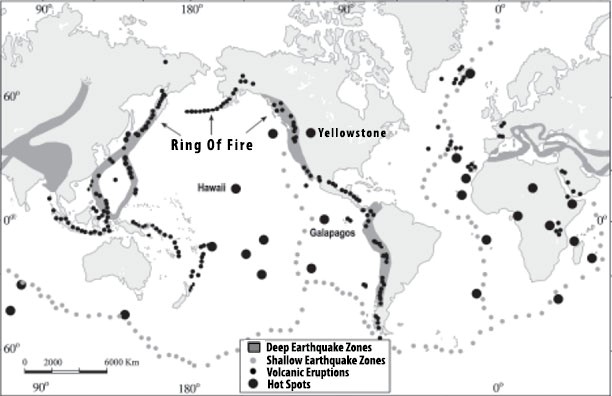
Tectonic activity at Diverging plates
At the place of divergence, new crust material is created. When plates move away from each other, the space between them gets filled with material, which rises to the surface, cools and forms mid-oceanic ridges. This creates shallow earthquake zones.
For example, The Pacific Ocean is growing wider by about 18 cm per year as the plates diverge and the mid-oceanic ridge is built up. The mid-Atlantic ridge is the best example of a divergent boundary.
| An interesting activity |
|
Can you locate all the mid-oceanic ridges using Google Maps? The most famous of all mid-oceanic ridges, the Mid-Atlantic ridge is shown below:
|
Relation between Volcanoes and earthquakes
Volcanoes and earthquakes are often found in the same place, but are they related? Does one trigger the other? The answer seems to be yes – but not always. They are sometimes linked but are often independent events.
When a volcano erupts, the pressure of the rising magma forcing its way through the crust to the surface will often trigger earthquake activity. Scientists have been able to demonstrate this link.
Conversely, an earthquake may trigger subsequent eruptions. As the crust changes and moves in a major earthquake, fissures or cracks can form that may act as pipelines for magma and future volcanoes. This is harder to monitor and test and is an area of active research.


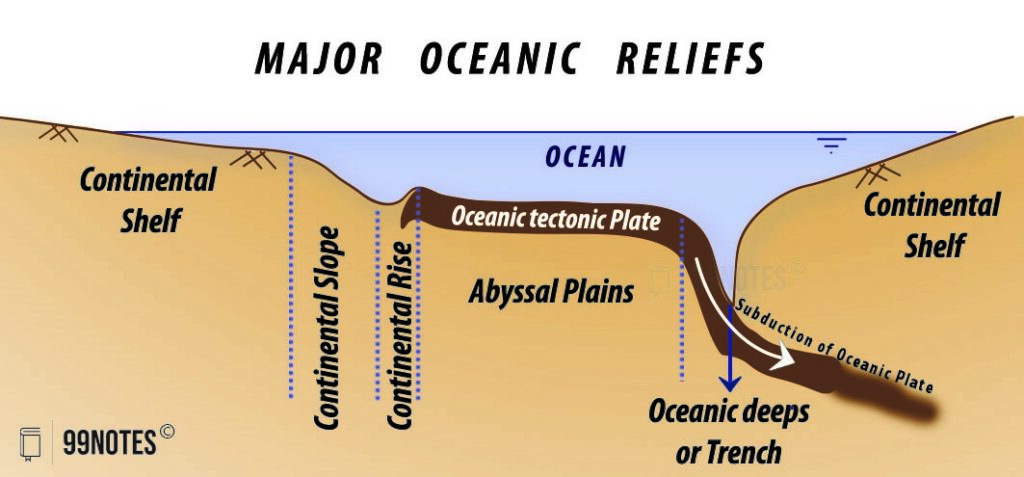 Apart from these, there are various minor oceanic reliefs such as Mid Oceanic ridges. We shall study them in chapter 13 in detail. The Mid-Oceanic ridges are a series of parallel underwater mountain ranges; The crustal plates split at these places spewing volcanic material from the centre, creating these parallel ranges. The study of these mid-oceanic ridges gives us an amazing insight into the tectonic plates.
Apart from these, there are various minor oceanic reliefs such as Mid Oceanic ridges. We shall study them in chapter 13 in detail. The Mid-Oceanic ridges are a series of parallel underwater mountain ranges; The crustal plates split at these places spewing volcanic material from the centre, creating these parallel ranges. The study of these mid-oceanic ridges gives us an amazing insight into the tectonic plates.